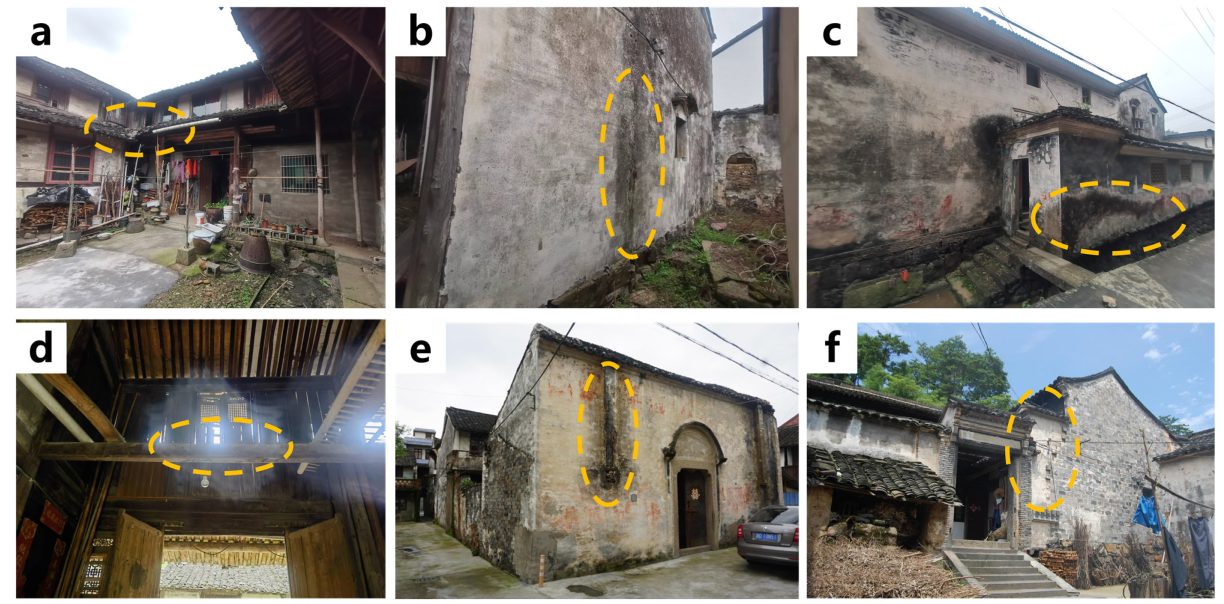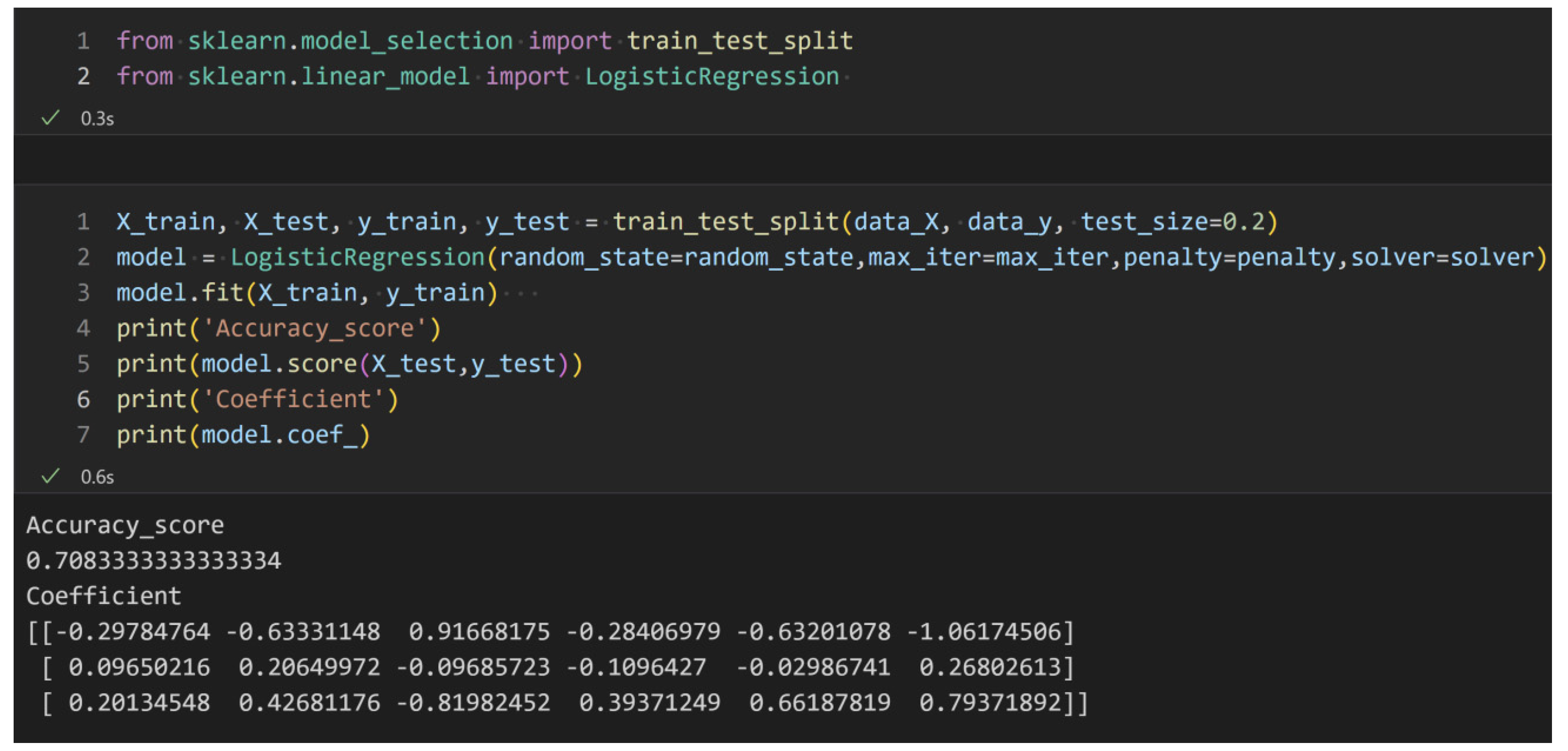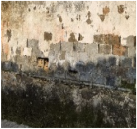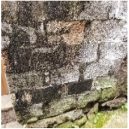Prediction of Deterioration Level of Heritage Buildings Using a Logistic Regression Model
Abstract
:1. Introduction
2. Methodology
2.1. Target Sample
2.2. Logistic Regression Analysis
3. Results and Discussion
3.1. Evaluation Factor
3.2. Interpretation of Evaluation Factor
3.2.1. Building Age and Type
3.2.2. Historical Value of Heritage Buildings
3.2.3. Historical Style and Features
3.2.4. Deterioration Level
3.3. Accuracy Test of the Model
4. Conclusions
Author Contributions
Funding
Data Availability Statement
Conflicts of Interest
References
- Zhou, W.; Song, S.; Feng, K. The sustainability cycle of historic houses and cultural memory: Controversy between historic preservation and heritage conservation. Front. Archit. Res. 2022, 11, 1030–1046. [Google Scholar] [CrossRef]
- Zhu, G. China’s architectural heritage conservation movement. Front. Archit. Res. 2012, 1, 10–22. [Google Scholar] [CrossRef] [Green Version]
- Zhang, T.; Xu, H.; Wang, C. Self-adaptability and topological deformation of Ganlan architectural heritage: Conservation and regeneration of Lianghekou Tujia village in Western Hubei, China. Front. Archit. Res. 2022, 11, 865–876. [Google Scholar] [CrossRef]
- Della Torre, S. Italian perspective on the planned preventive conservation of architectural heritage. Front. Archit. Res. 2021, 10, 108–116. [Google Scholar] [CrossRef]
- Cavalagli, N.; Kita, A.; Castaldo, V.; Pisello, A.; Ubertini, F. Hierarchical environmental risk mapping of material degradation in historic masonry buildings: An integrated approach considering climate change and structural damage. Constr. Build. Mater. 2019, 215, 998–1014. [Google Scholar] [CrossRef]
- Gaddi, R.; Cacace, C.; Di Menno di Bucchianico, A. The risk assessment of surface recession damage for architectural buildings in Italy. J. Cult. Herit. 2022, 57, 118–130. [Google Scholar] [CrossRef]
- Dong, Y.; Han, D.; Trisciuoglio, M. A graphical method of presenting property rights, building types, and residential behaviors: A case study of Xiaoxihu historic area, Nanjing. Front. Archit. Res. 2022, 11, 1077–1091. [Google Scholar] [CrossRef]
- García-Esparza, J.; Tena, P.A. A GIS-based methodology for the appraisal of historical, architectural, and social values in historic urban cores. Front. Archit. Res. 2020, 9, 900–913. [Google Scholar] [CrossRef]
- Kanth, A.; Soni, A. Application of nanocomposites for conservation of materials of cultural heritage. J. Cult. Herit. 2023, 59, 120–130. [Google Scholar] [CrossRef]
- Kopuz, A.; Bal, A. The conservation of modern architectural heritage buildings in Turkey: İstanbul Hilton and İstanbul Çınar Hotel as a case study. Ain Shams Eng. J. 2023, 14, 101918. [Google Scholar] [CrossRef]
- Ishizaki, T.; Takami, M. Deterioration of the Wall of a Historic Stone Building in a Cold Region and Measures to Protect it. Energy Procedia 2015, 78, 1371–1376. [Google Scholar] [CrossRef] [Green Version]
- Sitzia, F.; Lisci, C.; Mirão, J. Building pathology and environment: Weathering and decay of stone construction materials subjected to a Csa mediterranean climate laboratory simulation. Constr. Build. Mater. 2021, 300, 124311. [Google Scholar] [CrossRef]
- Wang, X.; Li, H.; Wang, Y.; Zhao, X. Assessing climate risk related to precipitation on cultural heritage at the provincial level in China. Sci. Total Environ. 2022, 835, 155489. [Google Scholar] [CrossRef]
- Gaspari, A.; Giongo, I.; Piazza, M. A risk-based approach for timber building decay prediction. Procedia Struct. Integr. 2022, 37, 811–819. [Google Scholar] [CrossRef]
- Sung, S.; Kang, Y.; Cho, H.; Kim, N.; Lee, S.; Choi, B.; Cho, G. Prediction of early neurological deterioration in acute minor ischemic stroke by machine learning algorithms. Clin. Neurol. Neurosurg. 2020, 195, 105892. [Google Scholar] [CrossRef]
- Uzun, Z.; Köse, C.; Köse, N. A multidisciplinary study to reveal the historical value of wooden structures and to develop a conservation approach: Dere and Karlı Mosques in Samsun, Turkey. J. Cult. Herit. 2018, 32, 60–72. [Google Scholar] [CrossRef]
- Gao, L.; Liu, T.; Cao, T.; Hwang, Y.; Radermacher, R. Comparing deep learning models for multi energy vectors prediction on multiple types of building. Appl. Energy 2021, 301, 117486. [Google Scholar] [CrossRef]
- Li, M.; Wang, Y.; Xu, Y.-Q. Computing for Chinese Cultural Heritage. Vis. Inform. 2022, 6, 1–13. [Google Scholar] [CrossRef]
- Liu, C.; Sepasgozar, S.; Zhang, Q.; Ge, L. A novel attention-based deep learning method for post-disaster building damage classification. Expert Syst. Appl. 2022, 202, 117268. [Google Scholar] [CrossRef]
- Mulvin, L.; Lewis, J.; O’Daly, G.; Olley, D.; Cooper, T.; O’Brien, P.; Dowding, D.P. A methodology for epidemiological studies of deterioration in historic stone buildings. In Science Technology and European Cultural Heritage; Baer, N., Sabbioni, C., Sors, A., Eds.; Butterworth-Heinemann: Oxford, UK, 1991; pp. 563–565. [Google Scholar]
- Wang, N.; Zhao, X.; Zhao, P.; Zhang, Y.; Zou, Z.; Ou, J. Automatic damage detection of historic masonry buildings based on mobile deep learning. Autom. Constr. 2019, 103, 53–66. [Google Scholar] [CrossRef]
- Antonov, A.; Khodnenko, I.; Kudinov, S. Façade deterioration prediction with the use of machine learning methods, based on objective parameters and e-participation data. Procedia Comput. Sci. 2021, 193, 42–51. [Google Scholar] [CrossRef]
- Menéndez, E.; Martín, L.G.; Salem, Y.; Jalón, L.; Hernández-Montes, M.C.A. Bayesian assessment of surface recession patterns in brick buildings with critical factors identification. Boletín Soc. Española Cerámica Vidr. 2022, 61, 357–373. [Google Scholar] [CrossRef]
- Vasanelli, E.; Fusco, G.; Quarta, G.; Calia, A. The use of drilling test to investigate the salt distribution in air lime mortars. J. Cult. Herit. 2022, 58, 49–56. [Google Scholar] [CrossRef]
- Waqas, U.; Ahmed, M.F. Investigation of strength behavior of thermally deteriorated sedimentary rocks subjected to dynamic cyclic loading. Int. J. Rock Mech. Min. Sci. 2022, 158, 105201. [Google Scholar] [CrossRef]
- Hoang, N.-D. Automatic detection of asphalt pavement raveling using image texture based feature extraction and stochastic gradient descent logistic regression. Autom. Constr. 2019, 105, 102843. [Google Scholar] [CrossRef]
- Pagounis, V.; Tsakiri, M.; Zacharis, V.; Andritsanos, V.; Tsiardaki, M. Detection of geometric changes for an historic theatre by comparing surveying data of different chronological periods. J. Cult. Herit. 2016, 21, 860–868. [Google Scholar] [CrossRef]
- Park, H.; Ryu, H.; Baik, J. Historical Value-Based Approach for Cost-Cognizant Test Case Prioritization to Improve the Effectiveness of Regression Testing. In Proceedings of the 2008 Second International Conference on Secure System Integration and Reliability Improvement, Yokohama, Japan, 14–17 July 2008; Volume 52, pp. 39–46. [Google Scholar]
- Scazzosi, L. Reading and assessing the landscape as cultural and historical heritage. Landsc. Res. 2004, 29, 335–355. [Google Scholar] [CrossRef]
- Robles-Velasco, A.; Cortés, P.; Muñuzuri, J.; Onieva, L. Prediction of pipe failures in water supply networks using logistic regression and support vector classification. Reliab. Eng. Syst. Saf. 2020, 196, 106754. [Google Scholar] [CrossRef]
- Runchi, Z.; Liguo, X.; Qin, W. An ensemble credit scoring model based on logistic regression with heterogeneous balancing and weighting effects. Expert Syst. Appl. 2023, 212, 118732. [Google Scholar] [CrossRef]
- Zhang, Z.-T.; Gao, W.-H.; Zeng, C.-F.; Tang, X.-Y.; Wu, J. Evolution of the disintegration breakage of red-bed soft rock using a logistic regression model. Transp. Geotech. 2020, 24, 100382. [Google Scholar] [CrossRef]
- Bevia, V.; Calatayud, J.; Cortés, J.; Jornet, M. On the generalized logistic random differential equation: Theoretical analysis and numerical simulations with real-world data. Commun. Nonlinear Sci. Numer. Simul. 2023, 116, 106832. [Google Scholar] [CrossRef]
- Hoffmann, E.; Wang, Y.; Werner, M.; Kang, J.; Zhu, X. Model Fusion for Building Type Classification from Aerial and Street View Images. Remote Sens. 2019, 11, 1259. [Google Scholar] [CrossRef] [Green Version]
- Jin, X.; Xiao, F.; Zhang, C.; Li, A. GEIN: An interpretable benchmarking framework towards all building types based on machine learning. Energy Build. 2022, 260, 111909. [Google Scholar] [CrossRef]
- Xiao, X.; Seekamp, E.; Lu, J.; Eaton, M.; van der Burg, M. Optimizing preservation for multiple types of historic structures under climate change. Landsc. Urban Plan. 2021, 214, 104165. [Google Scholar] [CrossRef]
- Wurm, M.; Schmitt, A.; Taubenböck, H. Building Types’ Classification Using Shape-Based Features and Linear Discriminant Functions. IEEE J. Sel. Top. Appl. Earth Obs. Remote Sens. 2016, 9, 1901–1912. [Google Scholar] [CrossRef]
- Laing, R. Built heritage modelling and visualisation: The potential to engage with issues of heritage value and wider participation. Dev. Built Environ. 2020, 4, 100017. [Google Scholar] [CrossRef]
- De la Torre, M. Values and Heritage Conservation. Herit. Soc. 2013, 6, 155–166. [Google Scholar] [CrossRef]
- Ferretti, V.; Bottero, M.; Mondini, G. Decision making and cultural heritage: An application of the Multi-Attribute Value Theory for the reuse of historical buildings. J. Cult. Herit. 2014, 15, 644–655. [Google Scholar] [CrossRef]
- Li, X.; Qin, R. Performance-based firefighting in dense historic settlements: An exploration of a firefighting approach combining value and risk assessment with numerical simulation. Front. Archit. Res. 2022, 11, 1134–1150. [Google Scholar] [CrossRef]
- Zhang, X.; Liu, X.; Chen, K.; Guan, F.; Luo, M.; Huang, H. Inferring building function: A novel geo-aware neural network supporting building-level function classification. Sustain. Cities Soc. 2023, 89, 104349. [Google Scholar] [CrossRef]
- Luo, J.; Jian, I.; Chan, E.; Chen, W. Cultural regeneration and neighborhood image from the aesthetic perspective: Case of heritage conservation areas in Shanghai. Habitat Int. 2022, 129, 102689. [Google Scholar] [CrossRef]
- Standoli, G.; Clementi, F.; Gentile, C.; Lenci, S. Post-earthquake continuous dynamic monitoring of the twin belfries of the Cathedral of Santa Maria Annunziata of Camerino, Italy. Procedia Struct. Integr. 2023, 44, 2066–2073. [Google Scholar] [CrossRef]
- Mishra, M.; Lourenço, P.B.; Ramana, G.V. Structural health monitoring of civil engineering structures by using the internet of things: A review. J. Build. Eng. 2022, 48, 103954. [Google Scholar] [CrossRef]
- Franke, L.; Schoppe, I. Deterioration of Historic Brick Buildings. In Science, Technology and European Cultural Heritage; Baer, N., Sabbioni, C., Sors, A., Eds.; Butterworth-Heinemann: Oxford, UK, 1991; pp. 418–421. [Google Scholar]
- Harirchian, E.; Hosseini, S.A.; Jadhav, K.; Kumari, V.; Rasulzade, S.; Işık, E.; Wasif, M.; Lahmer, T. A review on application of soft computing techniques for the rapid visual safety evaluation and damage classification of existing buildings. J. Build. Eng. 2021, 43, 102536. [Google Scholar] [CrossRef]
- EHoffmann, J.; Abdulahhad, K.; Zhu, X. Using social media images for building function classification. Cities 2023, 133, 104107. [Google Scholar] [CrossRef]



| Parameters | Poor | Medium | Good | Excellent | Standard | Actual Rating |
|---|---|---|---|---|---|---|
| Historical features (roofing, windows, doors, wall) | 0 | 1 | 2 | 3 | 3 | 2 |
| Architecture symbolic system | 0 | 1 | 2 | 3 | 3 | 3 |
| Color integration | 0 | 1 | 2 | 3 | 3 | 2 |
| Comprehensive rating | —— | 3 | 2.333 ≈ 2 | |||
| Deterioration Level | Especially Serious (Level 1) | Very Serious (Level 2) | Generally Serious (Level 3) | Slightly Serious (Level 4) | |
|---|---|---|---|---|---|
| Deterioration types | Alkali crystals | The surface layer of the stucco layer is peeling off, the mechanical properties of the block surface layer are weakened, and the structural members are exposed | The matrix is brittle, crumbly, or powder-like, adhering to the surface, and gradually deteriorating to the interior | Soluble salts are precipitated with the evaporation of water, and white crystals are attached to the masonry surface | The wall humidity increases and shows local color darkening and a water line and other moisture phenomena |
| Chalking | Chalking depth of block surface > 2 cm | Chalking depth of block surface > 1.5 cm | Chalking depth of block surface ≤ 1 cm | Chalking depth of block surface ≤ 0.5 cm | |
| Bulging | Cracking and partial peeling of the surface layer of stucco | Surface stucco cracking | Surface stucco cracking, into small cracks | The surface layer of stucco, slightly hollow drum, no cracking phenomenon | |
| Disintegration | Large area of block disintegration and falling off | Crumbling in smaller pieces | No significant disintegration | The surface of the wall is basically intact | |
| Cracks | Structural exposed corrosion, through cracks in walls | The block has obvious cracks, the gray joints fall off but do not form through joints | The block is basically intact, the gray joints appear to fall off seriously and form gaps | Ash joints partially pulverized, no obvious shedding, no coherent joints formed | |
| Appearing site | Bottom of the wall | Middle of the wall | Corner, cornice | Cornice, sill | |
| Structural layer | Structural layer corrosion Exposure of structural layer brick wall | Plaster priming layer Surface coating layer Brick wall | Plaster priming layer Surface coating layer | Plaster priming layer Surface coating layer | |
| Illustrations |  |  |  |  | |
| No. | Evaluation Factor | Model Prediction | Actual Deterioration Level | ||||||||
|---|---|---|---|---|---|---|---|---|---|---|---|
| X1 | X2_1 | X2_2 | X2_3 | X3 | X4 | y_1 | y_2 | y_3 | Deterioration Level | ||
| 1 | 1 | 1 | 0 | 0 | 2 | 2 | 0.26 | 0.58 | 0.16 | 2 | 2 |
| 2 * | 4 | 1 | 0 | 0 | 1 | 1 | 0.46 | 0.49 | 0.05 | 2 | 1 |
| 3 | 3 | 0 | 0 | 1 | 3 | 3 | 0.02 | 0.39 | 0.58 | 3 | 3 |
| 4 * | 3 | 1 | 0 | 0 | 1 | 1 | 0.56 | 0.4 | 0.04 | 1 | 2 |
| 5 | 3 | 1 | 0 | 0 | 2 | 2 | 0.13 | 0.65 | 0.22 | 2 | 2 |
| 6 * | 3 | 1 | 0 | 0 | 1 | 2 | 0.24 | 0.65 | 0.11 | 2 | 3 |
| 7 | 8 | 0 | 0 | 0 | 1 | 1 | 0.28 | 0.63 | 0.08 | 2 | 2 |
| 8 | 3 | 1 | 0 | 0 | 1 | 1 | 0.56 | 0.4 | 0.04 | 1 | 1 |
| 9 | 3 | 0 | 0 | 1 | 1 | 2 | 0.37 | 0.52 | 0.11 | 2 | 2 |
| 10 | 3 | 0 | 1 | 0 | 2 | 3 | 0.22 | 0.64 | 0.14 | 2 | 2 |
| 11 | 1 | 0 | 1 | 0 | 1 | 1 | 0.95 | 0.05 | 0 | 1 | 1 |
| 12 * | 3 | 0 | 1 | 0 | 2 | 2 | 0.53 | 0.41 | 0.05 | 1 | 2 |
| 13 | 5 | 1 | 0 | 0 | 2 | 2 | 0.06 | 0.67 | 0.27 | 2 | 2 |
| 14 * | 3 | 0 | 0 | 1 | 3 | 3 | 0.02 | 0.39 | 0.58 | 3 | 1 |
| 15 | 3 | 0 | 0 | 1 | 1 | 2 | 0.37 | 0.52 | 0.11 | 2 | 2 |
| 16 * | 1 | 0 | 0 | 1 | 1 | 3 | 0.24 | 0.58 | 0.18 | 2 | 3 |
| 17 | 3 | 1 | 0 | 0 | 1 | 1 | 0.56 | 0.4 | 0.04 | 1 | 1 |
| 18* | 5 | 0 | 0 | 1 | 1 | 1 | 0.52 | 0.42 | 0.07 | 1 | 2 |
| 19 | 3 | 0 | 0 | 1 | 2 | 2 | 0.22 | 0.55 | 0.24 | 2 | 2 |
| 20 | 3 | 1 | 0 | 0 | 3 | 2 | 0.06 | 0.56 | 0.37 | 2 | 2 |
| 21 | 3 | 0 | 0 | 1 | 1 | 2 | 0.37 | 0.52 | 0.11 | 2 | 2 |
| 22 | 3 | 0 | 0 | 1 | 3 | 3 | 0.02 | 0.39 | 0.58 | 3 | 3 |
| 23 | 7 | 1 | 0 | 0 | 4 | 3 | 0 | 0.23 | 0.77 | 3 | 3 |
| 24 | 3 | 1 | 0 | 0 | 1 | 2 | 0.24 | 0.65 | 0.11 | 2 | 2 |
| y | X1 | X2_1 | X2_2 | X2_3 | X3 | X4 |
|---|---|---|---|---|---|---|
| 1 | −0.298 | −0.633 | 0.917 | −0.284 | −0.632 | −1.062 |
| 2 | 0.097 | 0.206 | −0.097 | −0.11 | −0.03 | 0.268 |
| 3 | 0.201 | 0.427 | −0.82 | 0.394 | 0.662 | 0.794 |
Disclaimer/Publisher’s Note: The statements, opinions and data contained in all publications are solely those of the individual author(s) and contributor(s) and not of MDPI and/or the editor(s). MDPI and/or the editor(s) disclaim responsibility for any injury to people or property resulting from any ideas, methods, instructions or products referred to in the content. |
© 2023 by the authors. Licensee MDPI, Basel, Switzerland. This article is an open access article distributed under the terms and conditions of the Creative Commons Attribution (CC BY) license (https://creativecommons.org/licenses/by/4.0/).
Share and Cite
Chen, S.; Chen, J.; Yu, J.; Wang, T.; Xu, J. Prediction of Deterioration Level of Heritage Buildings Using a Logistic Regression Model. Buildings 2023, 13, 1006. https://doi.org/10.3390/buildings13041006
Chen S, Chen J, Yu J, Wang T, Xu J. Prediction of Deterioration Level of Heritage Buildings Using a Logistic Regression Model. Buildings. 2023; 13(4):1006. https://doi.org/10.3390/buildings13041006
Chicago/Turabian StyleChen, Si, Jingjing Chen, Jiming Yu, Tao Wang, and Jian Xu. 2023. "Prediction of Deterioration Level of Heritage Buildings Using a Logistic Regression Model" Buildings 13, no. 4: 1006. https://doi.org/10.3390/buildings13041006





